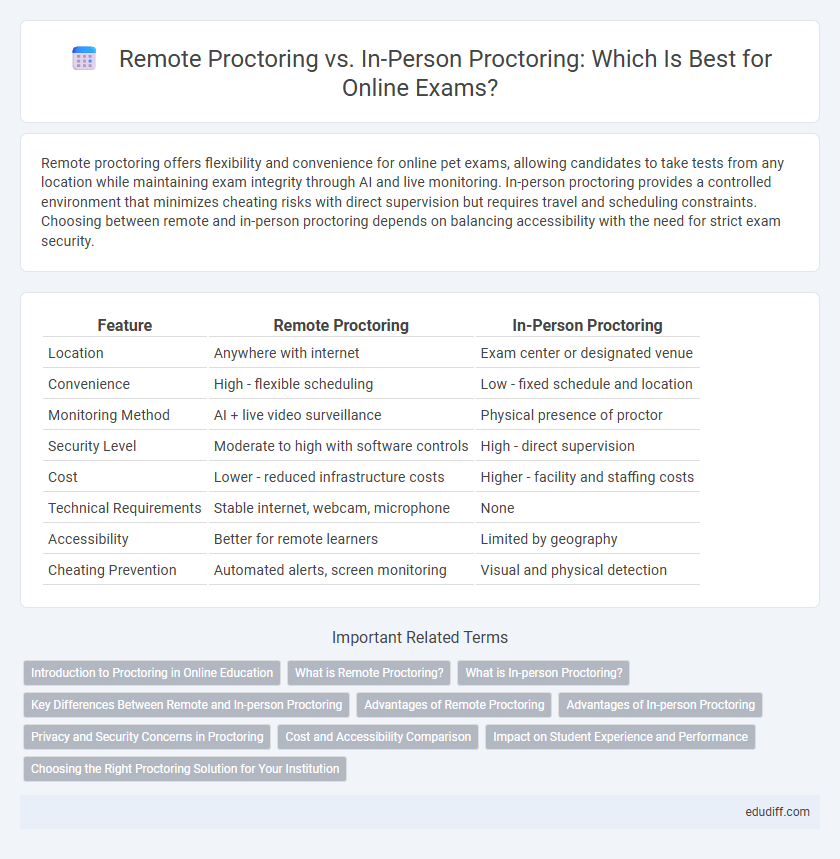Remote proctoring offers flexibility and convenience for online pet exams, allowing candidates to take tests from any location while maintaining exam integrity through AI and live monitoring. In-person proctoring provides a controlled environment that minimizes cheating risks with direct supervision but requires travel and scheduling constraints. Choosing between remote and in-person proctoring depends on balancing accessibility with the need for strict exam security.
Table of Comparison
| Feature | Remote Proctoring | In-Person Proctoring |
|---|---|---|
| Location | Anywhere with internet | Exam center or designated venue |
| Convenience | High - flexible scheduling | Low - fixed schedule and location |
| Monitoring Method | AI + live video surveillance | Physical presence of proctor |
| Security Level | Moderate to high with software controls | High - direct supervision |
| Cost | Lower - reduced infrastructure costs | Higher - facility and staffing costs |
| Technical Requirements | Stable internet, webcam, microphone | None |
| Accessibility | Better for remote learners | Limited by geography |
| Cheating Prevention | Automated alerts, screen monitoring | Visual and physical detection |
Introduction to Proctoring in Online Education
Remote proctoring employs advanced AI technology and live monitoring to ensure exam integrity in online education, reducing the need for physical presence. In-person proctoring involves supervised exams at designated locations, maintaining traditional security standards but limiting accessibility and flexibility. Both methods aim to uphold academic honesty, catering to different needs within digital learning environments.
What is Remote Proctoring?
Remote proctoring uses advanced technology such as AI-driven monitoring and live video surveillance to oversee exams conducted online, ensuring academic integrity without physical presence. It enables real-time identity verification, browser lockdown, and behavior analysis to prevent cheating during tests. This method offers flexibility and scalability compared to traditional in-person proctoring, making it ideal for remote or hybrid learning environments.
What is In-person Proctoring?
In-person proctoring involves a physical supervisor monitoring test-takers within a controlled environment to ensure exam integrity and prevent cheating. It requires candidates to attend a designated testing center where proctors verify identity, enforce time limits, and observe behaviors directly. This method offers high security but can be less flexible and more costly compared to remote proctoring solutions.
Key Differences Between Remote and In-person Proctoring
Remote proctoring utilizes AI technology and live monitoring to ensure exam integrity, contrasting with in-person proctoring's physical presence that directly observes test-takers. Remote exams offer flexibility and scalability but rely heavily on software for identity verification and cheating detection, whereas in-person proctoring provides immediate human intervention and stricter control over the exam environment. Security concerns with remote proctoring include potential privacy issues and internet connectivity problems, while in-person methods minimize technical risks but incur higher logistical costs.
Advantages of Remote Proctoring
Remote proctoring offers unparalleled flexibility, allowing students to take exams from any location without the need for physical presence, which reduces logistical costs and scheduling conflicts. Advanced AI-driven monitoring technology ensures exam integrity by detecting suspicious behavior in real-time, enhancing security compared to traditional methods. This method supports scalable administration for large institutions, accommodating thousands of candidates simultaneously while maintaining consistent proctoring standards.
Advantages of In-person Proctoring
In-person proctoring offers enhanced exam security through direct supervision, reducing the risk of cheating and technical issues common in remote settings. Physical presence allows proctors to monitor candidate behavior, ensuring adherence to test protocols and immediate intervention if suspicious activity occurs. This method supports a controlled environment that maintains exam integrity and fairness more effectively than remote alternatives.
Privacy and Security Concerns in Proctoring
Remote proctoring raises significant privacy concerns due to continuous video monitoring, data storage, and potential unauthorized access to personal information. In-person proctoring offers higher security by physically verifying identities and closely observing test-takers, reducing risks of cheating and data breaches. However, both methods require stringent protocols to protect sensitive exam data and ensure compliance with data protection regulations such as GDPR and FERPA.
Cost and Accessibility Comparison
Remote proctoring significantly reduces costs by eliminating the need for physical exam centers and on-site proctors, offering scalable solutions that accommodate large numbers of test-takers simultaneously. Accessibility improves as remote proctoring enables candidates from diverse geographic locations and with varying schedules to participate without travel expenses or time constraints. In contrast, in-person proctoring incurs higher costs related to facility rental and staffing, and limits accessibility due to geographic and logistical barriers.
Impact on Student Experience and Performance
Remote proctoring offers flexibility and convenience, allowing students to take exams in familiar environments, which can reduce anxiety and enhance focus. However, technical issues and privacy concerns may negatively affect performance and increase stress levels compared to in-person proctoring. In-person proctoring provides a controlled, distraction-free setting, ensuring exam integrity but can create pressure that may impair some students' performance.
Choosing the Right Proctoring Solution for Your Institution
Selecting the right proctoring solution involves evaluating factors like exam security, student privacy, and logistical feasibility. Remote proctoring offers scalability and convenience for online assessments, while in-person proctoring provides direct supervision and reduces technological risks. Institutions must balance cost-effectiveness and academic integrity when deciding between remote and in-person proctoring to meet their specific assessment needs.
Remote proctoring vs In-person proctoring Infographic

 edudiff.com
edudiff.com